By Emily Colucci, via vice.com
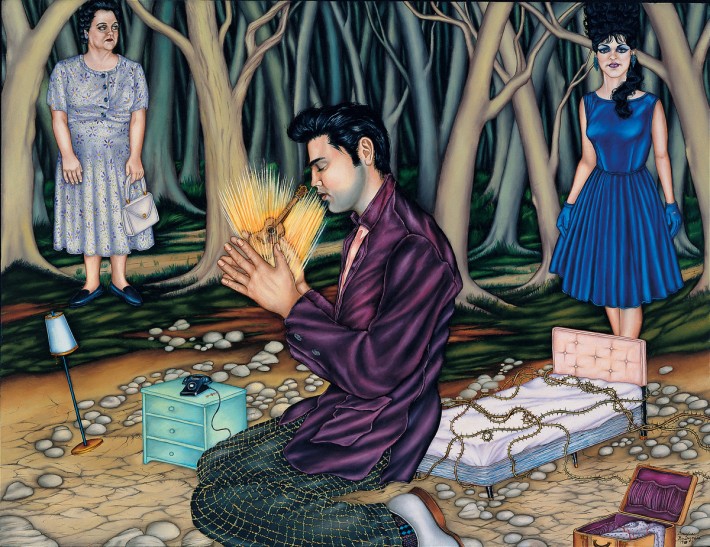
A New Place to Dwell, by Douglas Bourgeois
With 18 different venues spread throughout New Orleans from small arts spaces in Treme and Central City to major museums such as the New Orleans Museum of Art, the contemporary art biennial Prospect.3 certainly doesn’t make it easy for an individual to stand out from the over 50 participating artists in the show. But Southern Louisiana artist Douglas Bourgeois does that with his bizarrely beautiful paintings ranging from a saintly Elvis kneeling in reverence to his holy guitar with his beloved mother and Priscilla nearby to soul legend Bobby Womack and Lynchian torch singer Lana Del Rey performing a duet on the moon.

Womack and Del Ray, by Douglas Bourgeois
Though Prospect.3, which was as organized by artistic director and Los Angeles County Museum of Art curator Franklin Sirmans, has a distinctly international bent, Bourgeois’s vibrant art is thoroughly steeped in the cultural heritage of southern Louisiana. Born and currently living and working in the small rural community of St. Amant, where he returned in the 1980s after living in New Orleans for several years, Bourgeois’s art reflects the regions deep historical ties to music from the blues to jazz to R&B and hip-hop. Bourgeois’s work also features rich symbolism and a heavy dose of magical realism, creating a dreamlike visual landscape that appears both hallucinatory and thoroughly American.
With his works displayed in one corner of the Prospect.3 exhibition at the Contemporary Arts Center, I spoke with Bourgeois about the influence of southern Louisiana on his artwork, his artistic process, whether he sees his work as camp, and why he chose to paint that duet between Womack and Lana Del Rey.
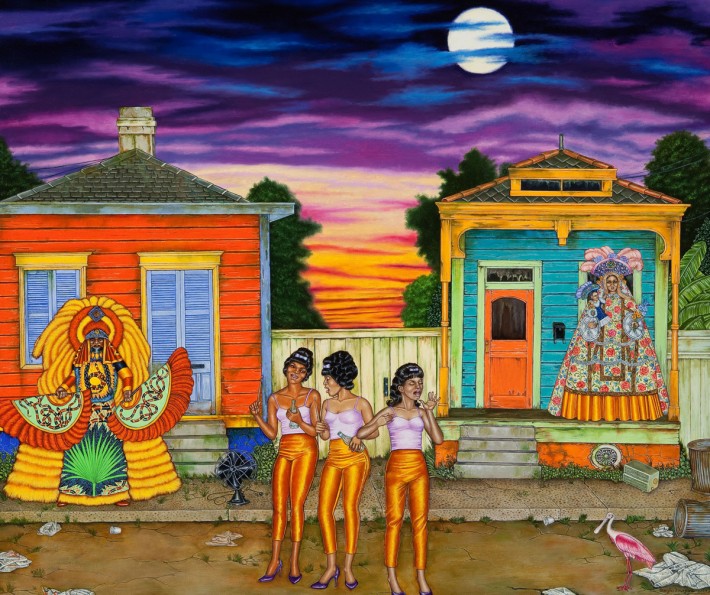
Iko-Ikon, by Douglas Bourgeois
VICE: How does Southern Louisiana influence your paintings?
Douglas Bourgeois: The humid air and lush subtropical landscape here are a big influence, just being steeped in it all the time. The music traditions from South Louisiana are more from memory imprints earlier in my life, from jukeboxes which used to be in most family restaurants or when wedding receptions were in a dance hall. When I lived in New Orleans briefly in the 1970s, a couple of second-line funeral processions passed by my house and I mistakenly thought those happened all the time, not yet knowing how serious an occasion that was. I also used to sit in the gospel tent during New Orleans Jazz Fest all day long and let it wash over me—it was so otherworldly and beautiful, I didn’t want to leave.
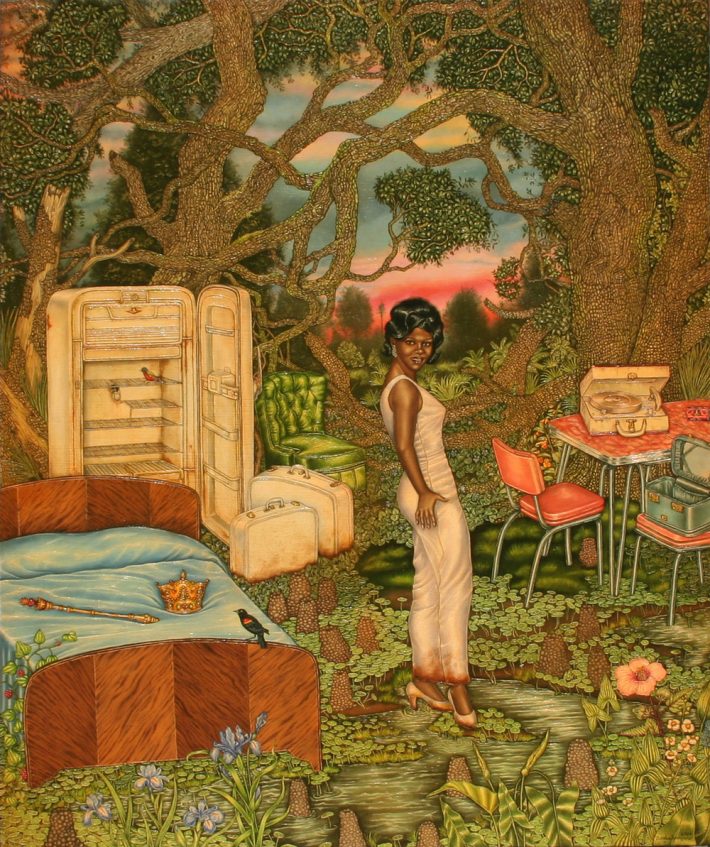
American Address, by Douglas Bourgeois
I’m fascinated by your frequent use of pop cultural figures from Elvis to Lana Del Rey. What interests you about these figures as subjects of your paintings?
Music has nourished me since I first heard Elvis’s “Hound Dog” as a little kid. Almost all the music I heard was from the radio and records, not live music. So I see recording artists as emissaries, as visionaries, flawed and human as they might be. I revere their gift to profoundly touch people, and honor them by putting them in the paintings. I’m also intrigued by the dichotomy of fame that these artists grapple with. How can a musician of widespread fame keep his or her sanity? It’s a tightrope walk, from what I’ve gleaned from all the biographies I’ve read.
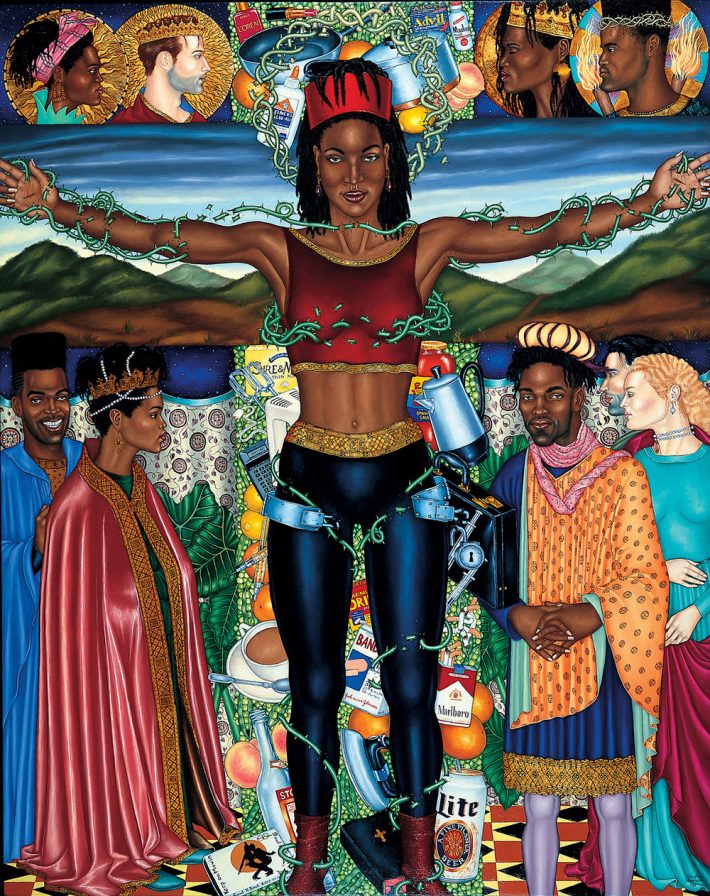
Her Dreams Were Like Medicine, by Douglas Bourgeois
Your representations of these pop cultural figures have a real saintly quality, particularly Elvis in A New Place to Dwell. Even your bold color choices remind me of Byzantine icons. Growing up Catholic, what role does Catholicism play in your work?
Since we lived far from urban areas and museums, the earliest artworks I saw were reproductions of Renaissance religious paintings and Byzantine icons in prayer missals. Also dime store religious repros were on the walls in everyday family homes. We also were given “holy cards” as students or when in summer catechism classes, sort of the equivalent of baseball cards for young Catholics.

Our Lady of the Monster Beats, by Douglas Bourgeois
On the other pop culture side of things, I saw Life magazine profiles and work by Jackson Pollock, Joseph Cornell, Van Gogh and Picasso.
Of your paintings in Prospect.3, the most recent is Womack and Del Ray. I’m curious about your choice to juxtapose soul legend Bobby Womack, who passed away this year, with a younger musician Lana Del Rey. Why did you choose to paint these two artists together?
I’ve occasionally placed seemingly unrelated artists together in paintings, as though they’d met across eras and genres—L’il Kim and Edgar Allen Poe, Emily Dickinson and Rakim, the Runaways and painter Otto Dix. Oddly enough, the pairing of Lana Del Rey and Bobby Womack was real, just ideal for a painting. They did a song together on Bobby Womack’s final album The Bravest Man in the Universe. I’ve always loved Womack’s voice and his gravelly plaintive singing paired with Del Rey’s ghostly torch vocals called out to me. The temporal change made was that Bobby Womack was younger in the painting, and they were singing on the moon. Bobby Womack died a few months after I’d finished the painting.

St. Anthony Appears to Tony, by Douglas Bourgeois
Your paintings are extremely complex, filled with intricate details and symbols. What is your artistic process?
The visual can come to me while driving, walking or mowing the lawn, when my mind is emptied of conscious thought, and if it’s a strong image that stays with me, I write a description and make a thumbnail sketch. Other images might come from seeing a music video or from a photo in a discarded book like Popular Mechanics. I make collages quite a bit and sometimes, a collage gets reborn as a painting.
I draw fairly detailed outlines on prepared panels. There’s a lot of erasure, all the preparatory sketching is beneath the paint. Facile drawing is not natural to me, so I really have to push it to the intended shape. The original image can change while being laid out—sometimes when the idea seems to be turning to shit, rearranging it can make it work out to something better than the originally imagined picture. Then I paint with oil media, basically background to foreground, top to bottom. Depending on the size, that takes me two to four months.
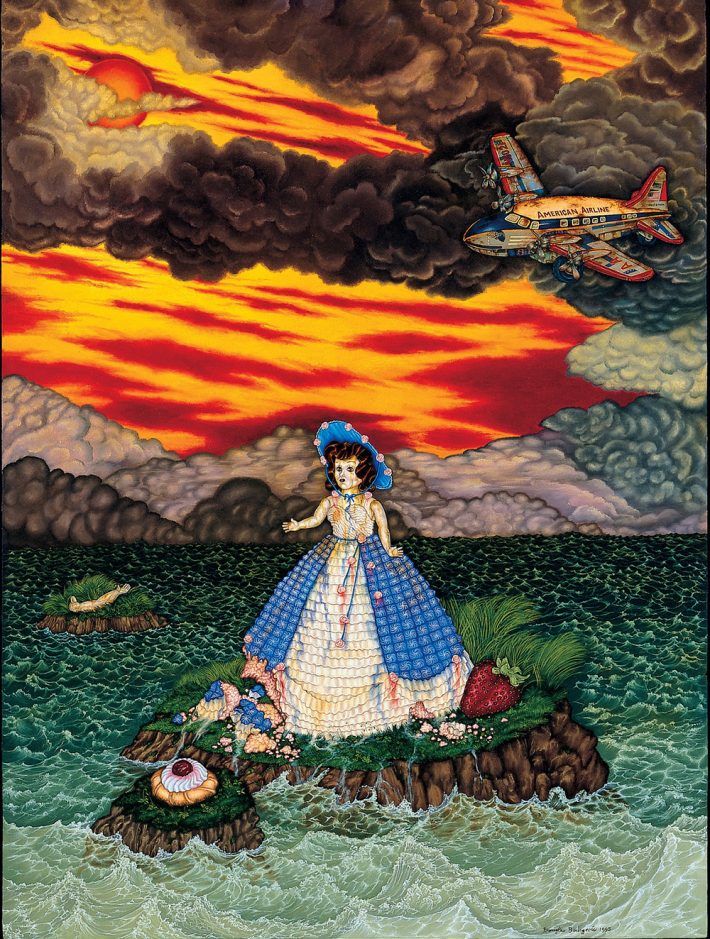
Dollcake at Sea, by Douglas Bourgeois
In an essay on your work by curator and Prospect New Orleans founder Dan Cameron, he references camp. Is camp important in your work? How?
I never thought about camp when doing the work. Other people saw that, more so in earlier paintings that were more brutal. As I got older, I became interested in a more serene strangeness, the extraordinary within the ordinary, fantastic visions even in a small town or seemingly dull environment. There’s still humor in it but it’s more melancholy.
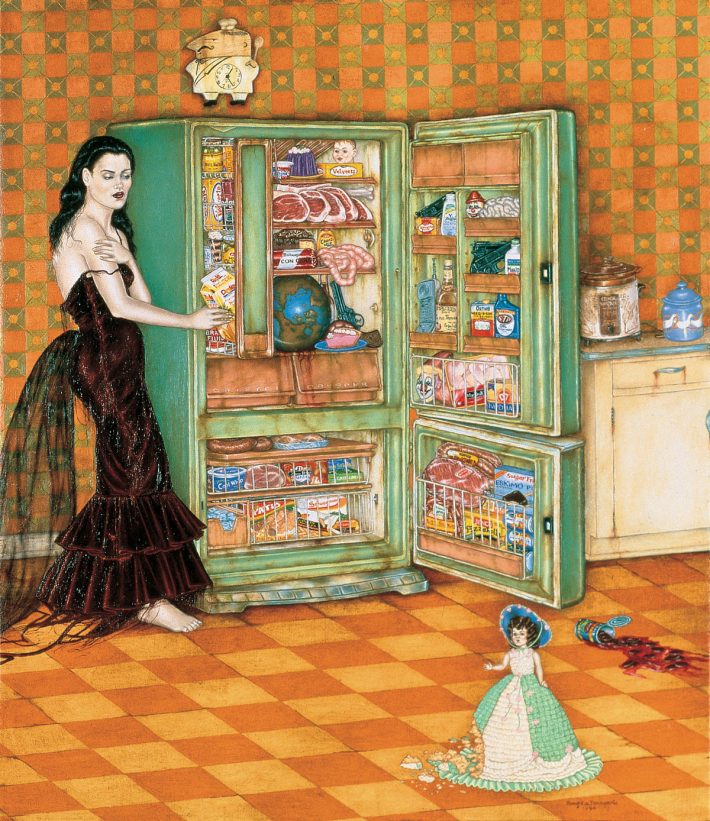
Refrigerator, by Douglas Bourgeois
Your work seems to blend pop art, surrealism, and magical realism. Who or what are your artistic inspirations?
There are so many artists whose work inspires me, here are just a few: Giotto, Giovanni Bellini, Gauguin, Egon Schiele, Alice Neel, Whitfield Lovell, Joseph Cornell, Diane Arbus, Kerry James Marshall, Renee Stout, Rosalie Gascoigne, Willie Birch, William Blake, Michael Northuis, Otto Dix, Edvard Munch, Frida Kahlo, Gregory Gillespie, Sue Coe. As indicated before, music such as deep soul, Southern gospel music, raw rock ‘n’ roll and Americana, independent hip-hop, R&B, pop—the way musical expression hybridizes and reinvents popular music.

Lamb, by Douglas Bourgeois
I’m also drawn to discarded paper media and ephemera, small objects, toys, obsolete electronics and machinery, animal illustrations, and children’s books.
Your contribution to Prospect.3 features paintings from the late 1970s to this year. With a selection from a wide range of your career, how do you see your work evolving through your career?
I think the earlier works were more obsessive about objects and filling every inch of a painting to maximum capacity. I see a little more breathing space in the works now and try for less density. I am still preoccupied with how people with unique compulsions (artists, musicians, writers, saints, seers, performers) try to function on Planet Earth, but recent works seem more accepting and less pissed off.
In future, I’d like to spend more time just drawing for its own sake, and see how that could impact paintings. Also I’d like to play with sound collage and video pieces.
Prospect.3 Biennial is open through January 25, 2015.
Emily Colucci is a New York–based writer and the co-founder of Filthy Dreams, a blog that analyzes culture through a queer lens. Follow her on Twitter.
